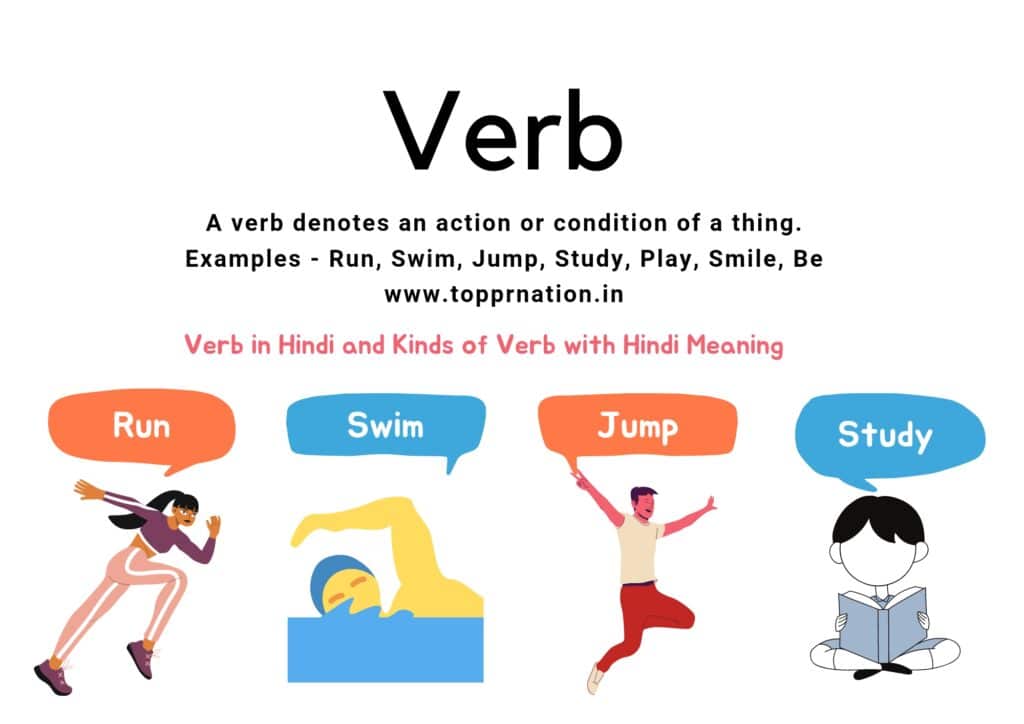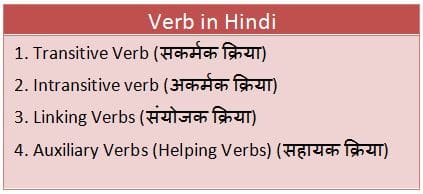Verb in Hindi – Meaning, Definition, Kinds and Examples of Verbs, क्रिया हिंदी में, Verb की Meaning हिंदी में, क्रिया की परिभाषा (definition of Verb), क्रिया के प्रकार (Kinds of Verb) और Examples of Verb (क्रिया के उदाहरण) सीखिए। अंग्रेजी सीखते समय Parts of Speech में सबसे महत्वपूर्ण Topic क्रिया Verb है।
Verb (क्रिया) के बिना किसी भी वाक्य का अर्थ पूरा नहीं हो सकता है अतः एक वाक्य को पूरा अर्थ देने में क्रिया का अत्यंत महत्वपूर्ण योगदान होता है। इस पोस्ट के माध्यम से आप Verb in Hindi तथा Kinds of Verb सीखेंगे।
Verb (क्रिया) वह शब्द है जो किसी व्यक्ति या वस्तु के बारे में कुछ कहता है, Verb कहलाता है। Verb शब्द लैटिन भाषा के Verbum से मिलकर बना है जिसका अर्थ है – a word (एक शब्द) क्रिया वाक्य का मुख्य शब्द होता है। कोई भी sentence बिना Verb के नहीं बनाया जा सकता है। यदि कोई वाक्य एक शब्द का है, वह शब्द अवश्य ही Verb होगा।

In this post, you will learn about the verb in Hindi with meaning and examples. Let’s read.
Read also: Parts of speech in Hindi
Verb in Hindi – Definition and Examples (क्रिया की परिभाषा व उदाहरण हिंदी में)
What is verb in Hindi?
Definition of Verb – A verb is a word used to show an action, state, process, and condition of a thing.
क्रिया क्या है?
Verb की परिभाषा – क्रिया एक ऐसा शब्द है जो किसी वस्तु के कार्य, अवस्था, प्रक्रिया और स्थिति को प्रदर्शित करने के लिए प्रयोग किया जाता है।
For examples – go (जाना), eat (आना), is (है) , was (था), sing (गाना), run (दौड़ना), have (पास होना), know (जानना), watch (देखना), search (खोजना), beat (पीटना), sink (डूबना) etc.
Remember: Tense and Voice are also parts of Verb. You may read about Tense in Hindi and Active and Passive Voice Rules in Hindi with exercises.
Examples of Verb in Hindi
Examples of Verb हिंदी में नीचे दिए गए हैं। इन्हें ध्यान से पढ़े व समझे।
1. Go. (जाओ।)
2. You Weep. (तुम रोते हो।)
3. She runs. (वह दौड़ती है।)
4. The girls are singing a sing. (लड़कियां गाना गा रही हैं।)
5. I don’t know. (मैं नहीं जानता हूं।)
6. The cost is very high. (कीमत बहुत अधिक है।)
7. They will need these documents. (उन्हें इन दस्तावेजों की आवश्यकता होगी।)
8. I have been working since Morning. (मैं सुबह से काम कर रहा हूं।)
9. Do not work here. (यहां काम मत करो।)
10. Please come back. (कृपया वापस आओ।)
11. He is simple person. (वह एक साधारण व्यक्ति है।)
ऊपर दिए Examples के वाक्यों में Green रंग में लिखे हुए शब्द क्रियाएं Verbs हैं। इन क्रियाओं का इस्तेमाल Subject के अनुसार करते हैं। यदि Subject Singular हो तो Verb भी Singular होती है तथा Subject Plural हो तो Verb भी Plural होती है।
Read also:
- 100 Examples of Verbs in Sentences
- Subject and Predicate
- Adverb in Hindi – Meaning and Definition
- Parts of Speech Exercises with answers
- Modal Auxiliary Verbs Exercises

Use of Verb in a sentence (क्रिया का प्रयोग वाक्यों में)
क्रिया का प्रयोग वाक्यों में निम्नलिखित बातों को व्यक्त करने के लिए किया जाता है।
1. क्रिया Verb से हमें किसी person या thing द्वारा किसी कार्य (Action) को करने का बोध होता है।
जैसे –
- The man cooks.
- She is running.
2. Verb से ज्ञात होता है कि किसी व्यक्ति या वस्तु के साथ क्या होता है या हुआ है।
जैसे –
- The toy is broken.
- Money is earned.
3. Verb से हमें किसी व्यक्ति दशा या स्थिति का पता चलता है।
जैसे –
- The child is sad.
- Raju was poor.
4. Verb से किसी वस्तु या व्यक्ति पर अधिकार का बोध होता है।
जैसे –
- He has a big palace.
- It is my bicycle.
Verb Meaning in Hindi
Verb का Hindi में अर्थ क्रिया होता है। Verb शब्द Noun (संज्ञा) है। वाक्यों को पूर्ण अर्थ देने के लिए सबसे मुख्य शब्द प्रयोग होता है, वह क्रिया है। हिंदी क्रियाओं के अंत में ‘ना’ अक्षर जुड़ा होता है।
Noun
- क्रिया
- क्रियापद
Pronunciation of Verb
- वर्ब (vûrb)
Examples of the verb – हंसना – Laugh, रोना – Weep, पढ़ना – read, लिखना -write, सोना-sleep, बैठना-sit, उठना-get up, रोकना-stop, चलाना-drive, शिकायत करना-complain, स्नान करना-bathe, टहलना-walk, रोकना-prevent, आदि।
Related words:
- Verbal
- Verbally
- Verbatim
- Verbose
Read also:
- Noun in Hindi
- Pronoun in Hindi
- Adjective in Hindi
- Adverb in Hindi
- Preposition in Hindi
- Conjunction in Hindi
Kinds/Types of Verbs in Hindi (क्रिया के प्रकार)
क्रिया को चार भागों में बाटा गया है। क्रिया के ये चार प्रकार निम्नलिखित हैं:
1. Transitive Verb (सकर्मक क्रिया)
2. Intransitive verb (अकर्मक क्रिया)
3. Linking Verbs (संयोजक क्रिया)
4. Auxiliary Verbs (Helping Verbs) (सहायक क्रिया)
Transitive and Intransitive Verb को Main Verb की रखते हैं। Main Verb का विस्तार से वर्णन आगे किया गया है। ऊपर दिए गए Kinds of Verb को विस्तार से नीचे दिया गया है।
Transitive Verb (सकर्मक क्रिया)
Definition of Transitive Verb – A verb which has an object is called a Transitive Verb.
सकर्मक क्रिया की परिभाषा – वह क्रिया जिसके साथ कर्म (object) होता है, सकर्मक क्रिया (Transitive Verb) कहलाती है।
Examples –
1. She has written a letter.
वह पत्र लिख चुकी है।
2. I am doing my work.
मैं अपना काम कर रहा हूं।
3. He is washing his clothes.
वह अपने कपड़े धो रहा है।
4. The man buys a car.
आदमी कार खरीदा है।
5. You don’t know him.
तुम उसे नहीं जानते हो।
6. The girl cannot clean the room.
लड़की कमरा साफ नहीं कर सकती है।
7. He stopped the bus at the bust stand.
उसने बस स्टैंड पर बस रोकी।
8. I didn’t teach him.
मैंने उसे नहीं पढ़ाया।
9. They were not playing cricket.
बे क्रिकेट नहीं खेल रहे थे।
10. We shall not publish the article tomorrow.
हम कल आर्टिकल को प्रकाशित नहीं करेंगे।
Transitive Verb पता करने की विधि
किसी वाक्य में सकर्मक क्रिया को पता करना करने के लिए उस बात का कर्म ज्ञात करना आवश्यक होता है object ज्ञात करने के लिए verb में ‘क्या’ और ‘किसी’ शब्द लगाकर प्रश्न करने पर जो Noun या Pronoun प्राप्त होता है, वह उस क्रिया का कर्म होता है। यदि कर्म ज्ञात नहीं होता है तो वह क्रिया सकर्मक नहीं है।
For example: She has written a letter.
ऊपर दिए गए sentence के लिए प्रश्न वह क्या लिख चुकी है? पूछने पर उत्तर में noun ‘a letter’ प्राप्त होता है जो कि verb ‘written’ का object है। अतः ऊपर दिए गए सभी वाक्यों की क्रियाएं सकर्मक क्रिया हैं।
Read also:
- Use of Do and Does in Hindi
- Use of This and That in Hindi
- Use of These and Those in Hindi
- Shall and Will Meaning in Hindi
Intransitive Verb (अकर्मक क्रिया)
Definition of Intransitive Verb – A verb which has not an object is called an Intransitive Verb
अकर्मक क्रिया की परिभाषा: वह क्रिया जिसके साथ कर्म (object) होता है, Intransitive Verb (अकर्मक क्रिया) कहते हैं।
For Examples –
1. Raj will laugh. (वह हंसेगा।)
2. You can smile. (तुम मुस्कुरा सकते हो।)
3. He is weeping. (वह रो रहा है।)
4. The black cow in the field is grazing. (काली गाय खेत में चर रही है।)
5. Mohan was bathing. (मोहन नहा रहा था।)
6. My brother has come. (मेरा भाई आ चुका है।)
7. The bus has stopped here. (बस यहां रुकी है।)
8. She played yesterday. (उसने कल खेला।)
9. You cannot play now. (तुम अब खेल नहीं सकते हो।)
10. The child ran. (बच्चा दौड़ा।)
ऊपर दिए हुए वाक्यों में underlined शब्द Intransitive Verb हैं। इन क्रियाओं के बाद कोई object नहीं आया है।
Difference between Transitive and Intransitive Verb
| Transitive Verb | Intransitive Verb |
| I will teach you. | The child weeps. |
| She can win the game. | You don’t smile. |
| We shall buy a bus. | They are not swimming. |
| They opened the box. | Gagan was coming. |
| The king killed the lion. | Geeta can dance. |
ऊपर दी गई टेबल के उदाहरणों से यह स्पष्ट है कि जिन क्रियाओं का object होता है। वे सकर्मक क्रिया होती हैं और जिनका object नहीं होता है, वे अकर्मक क्रिया होती हैं। यह नियम Linking Verb पर लागू नहीं होता है।
Main Verb and Auxiliary (मुख्य क्रिया तथा सहायक क्रिया)
Verb को मुख्यतः दो भागों में बांटा जाता है पहला भाग Main Verb तथा दूसरा Auxiliary Verb होता है। Main Verb को Finite तथा Non-Finite में विभाजित करते हैं। Auxiliary verbs को Primary auxiliary तथा Modal Auxiliary Verbs में बांटते हैं।
Finite Verb
A verb that changes its form according to the subject, number, and tense is called a Finite Verb.
वह क्रिया जो अपने Subject, Number तथा Tense के अनुसार अपना रूप बदलती है,Finite Verb कहलाती है।
जैसे –
- He runs.
- He is running.
- He has run.
- He ran yesterday.
- He was running.
उपरोक्त वाक्यों में Subject ‘he’ तथा verb ‘run’ का प्रयोग हुआ है। Verb ‘run’ हर वाक्य में अलग-अलग रूपों में आई है, run के रूप क्रमशः runs, running, run, ran तथा running हैं। क्रिया के यह रूप सब्जेक्ट नंबर तथा टेंस के अनुसार बदल गए हैं, अतः ‘run’ Finite Verb है।
Non-Finite Verb
A verb that does not change its form according to the subject, number, and tense.
वह verb जो अपने subject, number तथा tense के अनुसार अपना रूप नहीं बदलती है, Non-Finite Verb कहलाती है।
Examples –
- I like reading.
- She likes reading.
- They liked reading.
- I want to go.
- She wanted to go.
- Shyam wants to go.
उपरोक्त प्रारंभ के तीन वाक्यों में likes, likes, liked के बाद reading का प्रयोग हुआ है तथा अन्य तीन वाक्यों में want, wanted, wants के बाद to go का प्रयोग हुआ है। Reading तथा to go में कोई परिवर्तन नहीं हुआ है, अतः ये Non-Finite Verbs हैं।
Non-Finite Verbs तीन प्रकार की होती हैं।
- Infinitive (to +verb I)
- Participle (ed/en ending verb)
- Gerund (verb I + ing)
Examples –
- I want to run there. (Infinitive)
- Seeing his father, he ran away. (Gerund)
- They saw a wounded bird. (Participle)
Read more about Finite and Non Finite Verbs in Hindi
Forms of Verb (क्रिया के रूप)
क्रिया के मुख्य पांच रूप होते हैं। इन पांचों रूपों को समझने के लिए नीचे दी गई टेबल का ध्यान से अध्ययन करें।
| Verb | Verb I (Base Form) |
Verb II | Verb III | Verb IV | Verb V |
| To go | Go | went | gone | going | goes |
| To make | make | made | made | making | makes |
| To wash | wash | washed | washed | washing | washes |
| To come | come | came | come | coming | comes |
| To sing | sing | sang | sung | singing | sings |
| To write |
write | wrote | written | wrote | writes |
| To do | do | did | done | doing | does |
| To hit | hit | hit | hit | hitting | hits |
| To cut | cut | cut | cut | cutting | cuts |
| To clean | clean | cleaned | cleaned | cleaning | cleans |
Regular and irregular forms of the verb in Hindi.
Read also:
Linking Verb in Hindi (संयोजक क्रिया)
What is Linking Verb?
वह क्रिया जो वाक्य के Subject को उसके Complement से जोड़ती है, Linking Verb कहलाती है। is, am, are, was, were, आदि Linking Verbs हैं। यह verb ‘to be’ की forms हैं।
जैसे – The girl is brave.
उपरोक्त वाक्य में the girl कर्ता, is क्रिया तथा brave पूरक है। अर्थात the girl को brave से जोड़ने का कार्य is के द्वारा हो रहा है, अतः यह Linking Verb है।
Linking Verbs को Intransitive Verbs of Incomplete Prediction भी कहा जाता है।
Examples of Linking Verbs
1. The man is a doctor.
2. Sohan was a driver.
3. Your sisters are busy now.
4. I am your new English teacher.
5. They are farmers of this village.
6. You were happy yesterday.
Read also
Auxiliary Verb in Hindi (Helping Verb) सहायक क्रिया
परिभाषा – वह क्रिया जो मुख्य क्रिया की काल बनाने में मदद करती है, उसे Auxiliary Verb (सहायक क्रिया) कहते हैं।
Definition of Auxiliary Verb – The verb which helps in forming the tense of the main verb is called an auxiliary verb.
Examples –
1. The man is working hard.
2. Shyam has already heard this news.
3. They will provide the best service.
4. We were watching a movie in the cinema hall.
5. Gauri can do this work.
6. I could not come.
7. He did not receive any letter.
8. You should love your family.
ऊपर दिए गए वाक्यों में underline किए गए auxiliary verbs is, has, will, can, could, did, should, जो Main Verbs क्रमशः working, heard, provide, watching, do, come, receive तथा love Tense के निर्माण में सहायता कर रही हैं।
Kinds of Auxiliary Verbs
Auxiliary Verbs दो प्रकार की होती हैं।
- Primary Auxiliary Verbs
- Modals Auxiliary Verbs
Primary Auxiliary Verbs
Primary Auxiliary Verbs को हिंदी में प्राथमिक सहायक क्रिया कहते हैं। यह तीन प्रकार की होती हैं तथा इनके रूप अलग-अलग होते हैं। विस्तार से समझने के लिए नीचे दी गई टेबल को ध्यान से पढ़ें।
| Primary Auxiliary Verbs | Present Tense | Past Tense |
| To be | is, am, are | was, were |
| To do | do, does | did |
| To have | has, have | had |
Examples –
- She is not my friend.
- They are not sad today
- I am intelligent.
Modal Auxiliary Verbs
रूपात्मक या विधिसूचक सहायक क्रियाएं (Modal Auxiliary Verbs) निम्नलिखित प्रकार की होती हैं। नीचे दी गई सूची में Modal Auxiliary Verbs को उदाहरण सहित समझाया गया है।
Examples – Can, Could, May, Might, Must, Should, Will, Shall, Would, Ought to, Used to, Need, Dare
- You can jump.
- We could not come yesterday.
- It may rain tonight.
- We must follow the rules of traffic.
- We should take a bath daily.
- I shall go through this forest.
- They will not clean the kitchen.
- He would smoke in his childhood.
- We ought to love our country.
- Gandhiji used to spin.
- They need not go there.
- She dare not answer the question.
You may also like:
-
- Present Indefinite Tense in Hindi
- Present Continuous Tense in Hindi
- Present Perfect Tense in Hindi
- Present Perfect Continuous Tense in Hindi
- Past Indefinite Tense in Hindi
- Past Continuous Tense in Hindi
- Past Perfect Tense in Hindi
- Past Perfect Continuous Tense in Hindi
- Future Indefinite Tense in Hindi
- Future Continuous Tense in Hindi
- Future Perfect Tense in Hindi
- Future Perfect Continuous Tense in Hindi
Conclusion
In this post, you have studied verb in Hindi with meaning rules and kinds of verbs in detail. While using any verb in a sentence, it must be remembered. A verb must be used according to person and tense. There are many verbs which are used to show the actions of a subject. In this post, we have explained the kinds of verb in Hindi with their examples.
- Easy Hindi to English Translation - March 20, 2024
- Present Tense in Hindi – परिभाषा, प्रकार तथा उदाहरण - March 17, 2024
- Personal Pronoun in Hindi – Definition, Examples and Rules - March 8, 2024


It was very useful for it save our students and teachers by these page I really want to thankyou for this wonderful definition it cleared up all my doubts thank you toppernation 👍
Thank you for your response!! Keep Learning.
apne intransitive verb mai hindi means wrong likha hai
otherwise very helpful.
thankyou